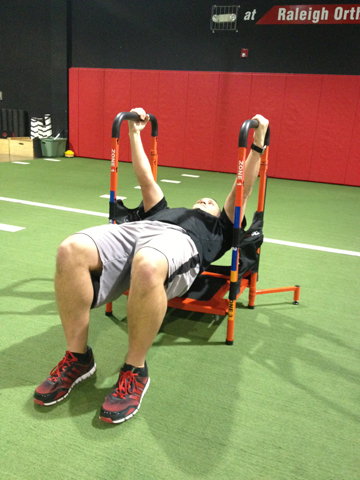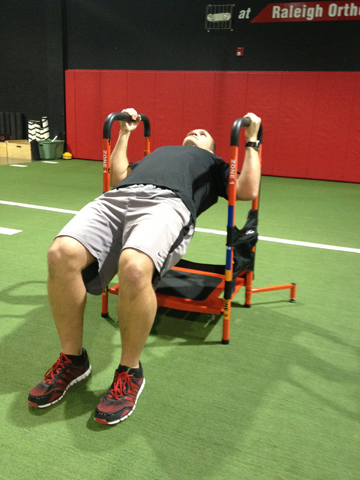
The next 3-4 columns will focus on the 10 in one Platform Trainer by TAG Fitness. This exercise demonstrates how to increase upper body pulling strength in a suspended fashion. The design of this equipment allows for different progressions and adjustments of the body's lever arm to pull body weight against gravity.
Execution:
Begin by adjusting the platform height low enough to enable both arms to be fully outstretched (elbows extended) without the upper back contacting the platform in the bottom position. Next, hold the top supports, extend the legs (feet positioned shoulder width apart) and pull the body up as you flex the elbows. Pause at the top, and then slowly lower back down to the start position.
Strive to maintain a straight-line position from head to toe throughout the movement by maintaining an active core in the ascent and descent. Perform 2-3 sets for time (30-45 sec) or until fatigue begins to impact form. Avoid using momentum and segmental movement at all times.
Modifications:
For those with limited upper body strength or poor core stability, decrease the lever arm by bending the knees in the start position. Gradually walk the heels out away from the body as you get stronger.
Progression:
Increase the time under tension by increasing the time of the descent phase. Keep in mind the biceps will fatigue much faster than the latissimus and shoulder retractors, thus limiting output. For advanced users, consider a single arm row method (see photo above). In this more challenging version, start with bent knees and gradually extend the knees provided form and strength allow. The free arm would remain straight and point toward the ceiling.
Application:
Developing pulling strength is important for balancing the body (posture and strength) as well as aiding athletic performance and daily function. The suspension row is a great way to increase not only upper body strength but overall body control and awareness in a more anti-gravity position compared to traditional seated machine or cable rows. Learning to maintain core activation and body alignment is important for runners and recreational/competitive athletes alike. The 10 in one Platform Trainer effectively allows for a graded approach to increase strength and challenge higher level clientele with the single arm row progression.
Brian Schiff, PT, OCS, CSCS, is a licensed physical therapist, respected author and fitness professional. Currently, he serves as the supervisor for Athletes' Performance at Raleigh Orthopaedic in Raleigh, NC. Brian conducts live continuing education webinars and presents nationally at professional conferences and seminars on injury prevention, rehab and sport-specific training. For more information on his products and services, visit www.BrianSchiff.com.
Execution:
Begin by adjusting the platform height low enough to enable both arms to be fully outstretched (elbows extended) without the upper back contacting the platform in the bottom position. Next, hold the top supports, extend the legs (feet positioned shoulder width apart) and pull the body up as you flex the elbows. Pause at the top, and then slowly lower back down to the start position.
Strive to maintain a straight-line position from head to toe throughout the movement by maintaining an active core in the ascent and descent. Perform 2-3 sets for time (30-45 sec) or until fatigue begins to impact form. Avoid using momentum and segmental movement at all times.
 |  |
Modifications:
For those with limited upper body strength or poor core stability, decrease the lever arm by bending the knees in the start position. Gradually walk the heels out away from the body as you get stronger.
 |  |
Progression:
Increase the time under tension by increasing the time of the descent phase. Keep in mind the biceps will fatigue much faster than the latissimus and shoulder retractors, thus limiting output. For advanced users, consider a single arm row method (see photo above). In this more challenging version, start with bent knees and gradually extend the knees provided form and strength allow. The free arm would remain straight and point toward the ceiling.
Application:
Developing pulling strength is important for balancing the body (posture and strength) as well as aiding athletic performance and daily function. The suspension row is a great way to increase not only upper body strength but overall body control and awareness in a more anti-gravity position compared to traditional seated machine or cable rows. Learning to maintain core activation and body alignment is important for runners and recreational/competitive athletes alike. The 10 in one Platform Trainer effectively allows for a graded approach to increase strength and challenge higher level clientele with the single arm row progression.
Brian Schiff, PT, OCS, CSCS, is a licensed physical therapist, respected author and fitness professional. Currently, he serves as the supervisor for Athletes' Performance at Raleigh Orthopaedic in Raleigh, NC. Brian conducts live continuing education webinars and presents nationally at professional conferences and seminars on injury prevention, rehab and sport-specific training. For more information on his products and services, visit www.BrianSchiff.com.
















